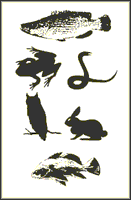Nebraska Cooperative Fish and Wildlife Research Unit

Nebraska Cooperative Fish and Wildlife Research Unit: Staff Publications
ORCID IDs
Mark A. Kaemingk http://orcid.org/0000-0001-9588-4563
Casey W. Schoenebeck http://orcid.org/0000-0002-4787-574X
Date of this Version
2020
Citation
Published in Lake and Reservoir Management 36:1 (2020), pp 64–74.
doi:10.1080/10402381.2019.1637977
Abstract
Managing fisheries that exhibit variable annual recruitment is challenging, and maintenance stockings are often prescribed to minimize interannual population variation. Maintenance stockings are costly and may not be necessary if sufficient natural recruitment is occurring. Therefore, developing tools and techniques that can collectively assess hatching origin and subsequent habitat use of individuals would be valuable. Herein, we aimed to assess the efficacy of otolith chemistry techniques to (1) determine whether there was evidence of natural recruitment within an annually stocked white bass population and (2) examine the potential to describe spatial reservoir use of these age-0 fish. A sample of hatchery-produced fingerling white bass (n = 17) was retained from a larger June 2015 stocking of white bass in Lake McConaughy, Nebraska, to characterize the hatchery fish natal elemental signatures. Age-0 white bass (n = 100) were then collected in Lake McConaughy in September 2015 from 2 sections of the reservoir (upper and main) to assess both natal origin (hatchery versus natural) and habitat use (upper versus main) using otolith concentrations of 5 chemical constituents at the otolith core and otolith edge, respectively. Otolith core signatures from the fall age-0 Lake McConaughy collected fish were different from the hatchery fish, indicating evidence for natural white bass recruitment. Otolith edge signatures were also distinct between fish collected from the upper and main sections of the reservoir. Otolith chemistry techniques can be useful for addressing challenges associated with managing erratic recruiting fish populations that are common to lake and reservoir systems.
Included in
Aquaculture and Fisheries Commons, Environmental Indicators and Impact Assessment Commons, Environmental Monitoring Commons, Natural Resource Economics Commons, Natural Resources and Conservation Commons, Water Resource Management Commons


Comments
Copyright © 2019 North American Lake Management Society. Published by Taylor & Francis. Used by permission.